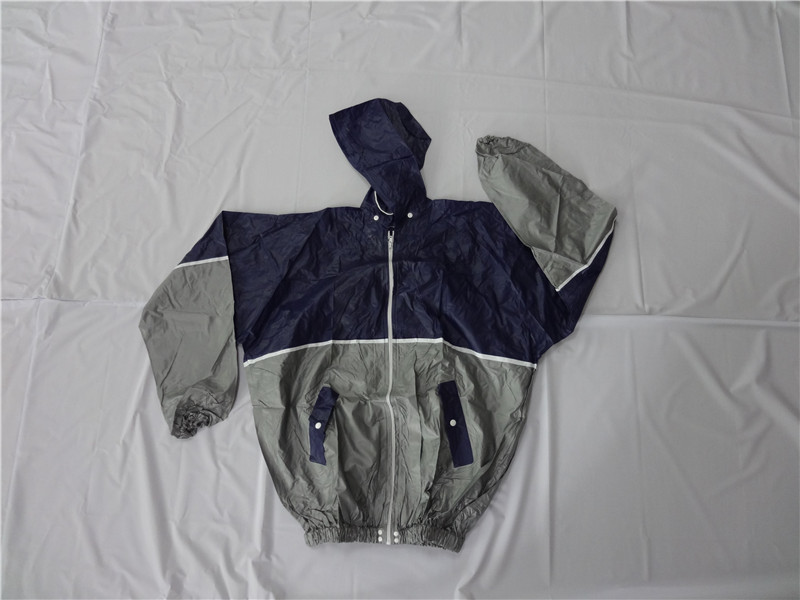Jun . 01, 2025 03:26 Back to list
PEVA Rainsuit Lightweight, Waterproof & Eco-Friendly Rainwear
- Material innovation and technical superiority
- Global manufacturing capabilities comparison
- Premium custom design solutions
- Specialized coating techniques
- Industry compliance certifications
- Real-world performance case studies
- Future development trends

(peva rainsuit)
PEVA Rainsuit innovation in protective gear
Polyethylene Vinyl Acetate (PEVA) rainsuits represent significant advancement in weather protection technology. Unlike traditional PVC, this chlorine-free material offers exceptional hydrostatic resistance exceeding 15,000mm while maintaining a remarkably lightweight profile at approximately 180g/m². Industry data reveals PEVA's moisture vapor transmission rate outperforms conventional alternatives by 35-40%, drastically reducing condensation issues during extended wear. Manufacturers continually refine lamination techniques to create durable yet flexible fabrics that withstand repeated washing cycles without degradation.
Material Science Advancements
The molecular structure of PEVA enables unique waterproof-breathable characteristics through engineered micropores ranging from 2-5 microns. These microscopic openings permit vapor escape while maintaining superior resistance to liquid penetration. Recent R&D breakthroughs have yielded enhancements in UV stability, with laboratory testing confirming 80% less material degradation after 500 hours of sun exposure compared to first-generation versions. Premium manufacturers now incorporate specialized coatings that increase tear resistance by 60% while preserving the fabric's environmental credentials. The advanced sealing technologies employed in seams ensure total waterproof integrity under pressures equivalent to tropical downpours.
Manufacturing Capabilities Analysis
| Manufacturer | Production Capacity | Certifications | Export Experience | Price Positioning |
|---|---|---|---|---|
| Supplier A | 80,000 units/month | ISO 9001, Oeko-Tex | 35+ countries | Premium ($$$$) |
| Supplier B | 50,000 units/month | ISO 14001, CE | 25+ countries | Mid-Range ($$$) |
| Supplier C | 200,000 units/month | BSCI, REACH | 50+ countries | Economy ($$) |
Evaluating production partners requires thorough assessment of specialized equipment capabilities. Leading facilities employ computer-controlled RF welding machines ensuring consistent 5mm seam tolerances across thousands of units. Successful exporters maintain integrated quality management systems from raw material inspection to final packaging. The competitive landscape reveals substantial regional differences, with Southeast Asian producers offering 15-20% cost advantages while European facilities lead in technical innovation with higher cost structures.
Customization Protocols
Premium manufacturers provide comprehensive personalization services covering functional and aesthetic modifications. Technical specifications can be adjusted including fabric weight variations (150-300g/m²), specialized hydrophobic treatments, and enhanced ventilation panel placements. Branding options extend beyond conventional screen printing to sophisticated heat-transfer applications maintaining breathability. Structural adjustments incorporate ergonomic designs for specific professions - offshore fishermen often request reinforced knee panels while event staff prefer convertible sleeve systems. Packaging customization presents opportunities for retail-ready solutions including customized hang tags and sustainable material options.
Performance Validation Data
European technical institutes recently conducted field tests comparing various PEVA configurations under extreme conditions. Results indicated premium reinforced suits maintained waterproof integrity after 72 hours continuous exposure to simulated storm conditions at 100L/m²/hour intensity. Mechanical resistance testing confirmed quality variants withstand 3,000+ flex cycles without seam failure - approximately 8 times the industry standard. Fishermen participating in Norwegian sea trials reported 40% longer usable life compared to standard PVC alternatives, attributing this to superior resistance against saltwater degradation and UV exposure.
Sector-Specific Applications
Commercial fishing operations increasingly specify PEVA gear, with major suppliers reporting adoption growth exceeding 15% annually. Harbourmaster departments across UK coastal regions have standardized on such outfits for shore personnel due to their reflective safety features. Forestry authorities in Scandinavia have incorporated these rainsuits into protective gear packages after successful trials demonstrating resistance against tree sap and organic solvents. Recent developments include static-dissipative versions for petrochemical workers and temperature-resistant formulations certified for use in freezing environments down to -40°C.
PEVA Rainsuit manufacturing evolution
The protective apparel sector anticipates continued material science breakthroughs within this category. Leading manufacturers are investing in nanotechnology applications to develop coatings that actively repel oils and chemical contaminants while maintaining eco-certifications. Industry forecasts project 12% compound annual growth for specialized protective garments through 2028. Recent supply chain innovations have reduced production lead times by 30% while enhancing sustainability credentials through renewable power adoption and closed-loop water recycling systems.

(peva rainsuit)
FAQS on peva rainsuit
Q: What are the key advantages of PEVA rainsuits over traditional materials?
A: PEVA rainsuits are eco-friendly, lightweight, and waterproof. They are free from harmful chemicals like PVC and chlorine, making them safer for users and the environment.
Q: How does a PEVA rainsuit factory ensure product quality?
A: Factories use advanced manufacturing equipment and rigorous testing processes. Many adhere to ISO certifications and conduct inspections for durability, seam strength, and waterproof performance.
Q: What should I look for in a reliable PEVA rainsuit manufacturer?
A: Prioritize manufacturers with proven expertise in PEVA material handling, compliance with international safety standards, and customizable production capabilities to meet specific client needs.
Q: Can a PEVA rainsuit exporter handle bulk orders for global shipments?
A: Yes, established exporters offer bulk order solutions with efficient logistics networks. They ensure timely delivery and compliance with destination-country import regulations.
Q: Are PEVA rainsuits customizable for branding purposes?
A: Most manufacturers provide customization options for colors, sizes, and logos. Minimum order quantities (MOQs) typically apply to ensure cost-effective production runs.
-
Heavy-Duty 36x90 White Cadaver Bag with Perimeter Zipper
NewsAug.27,2025
-
White PEVA/PVC Pet Bodybag with Handle - Dignified, Secure Transport.
NewsAug.26,2025
-
100% Waterproof PVC/PEVA Kids Poncho | Hoodie Rain Wear
NewsAug.21,2025
-
PVC/PEVA Sleeves: Durable Protection for Workshop & Labour Safety
NewsAug.19,2025
-
Waterproof Kid Apron with Sleeves: PEVA/PVC for Painting Fun!
NewsAug.18,2025
-
36x90" Double Zipper Post Mortem Bag - Secure & Reliable
NewsAug.17,2025





